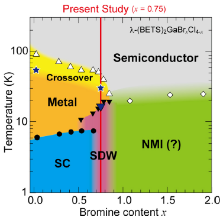The interplay between magnetic order or charge order, on the one hand, and superconductivity, on the other hand, attracts great attention; of particular interest are organic charge-transfer salts, for which the superconducting state is found on the border between metal and insulator. In κ-(BEDT-TTF)2X organic conductors, strong dimerization of BEDT-TTF donor molecules leads to effectively half-filled bands with the main physics governed by the on-site Coulomb repulsion U. The superconducting state for such systems is placed next to the antiferromagnetically-ordered insulating state, and spin-fluctuation driven mechanism of superconductivity was proposed here. In contrast to κ-type, in β"-(BEDT-TTF)2X salts the absence of dimerization leads to three-quarter-filled conduction bands; hence the inter-site Coulomb repulsion V becomes more important and gives rise to a charge-ordered insulating ground state, which is neighboring with the superconducting one. For these systems, superconductivity is mediated by the charge fluctuations and the charge degree of freedom is more important.
λ-(BETS)2GaCl4 organic superconductor takes a special place compared to κ- and β"- type salts. In λ-(BETS)2GaCl4 spin-fluctuations are found that originate from the neighboring spin-density-wave state. Here the study of the λ-(BETS)2GaBrxCl4-x series was crucial because bromine substitution is equivalent to negative chemical pressure [1,2]. Recently we could show that charge fluctuations are also present in λ-(BETS)2GaCl4. This implies that a theoretical description has to consider both on-site and inter-site Coulomb repulsion, U and V. It also means that in λ-type organic conductors both spin- and charge- mediated mechanisms of superconductivity are important. According to theoretical predictions for the certain ratio of U and V on a square lattice at half-filling, spin- and charge-density-wave states can coexist near the superconducting state. The aim is to explain superconductivity in λ-(BETS)2GaCl4 salts by taking into account the presence of both spin and charge fluctuations.
In this project λ-(BETS)2GaBrxCl4−x (x=0,75; 1) salts, which are placed between superconducting and non-magnetic insulating states, will be investigated by means of infrared spectroscopy and X-band ESR technique for understanding the mechanism of superconductivity in λ-type organic conductors.
Literature:
[1] H. Tanaka, A. Kobayashi, A. Sato, H. Akutsu, and H. Kobayashi, Chemical control of electrical properties and phase diagram of a series of λ-type BETS superconductors, λ-(BETS)2GaBrxCl4−x, J. Am. Chem. Soc. 121, 760 (1999).
[2] T. Kobayashi, T. Ishikawa, A. Ohnuma, M. Sawada, N. Matsunaga, H. Uehara, and A. Kawamoto, Spindensity wave in the vicinity of superconducting state in λ-(BETS)2GaBrxCl4−x probed by 13C NMR spectroscopy, Phys. Rev. Research 2, 023075 (2020).
[3] S. Onari, R. Arita, K. Kuroki, and H. Aoki, Phase diagram of the two-dimensional extended Hubbard model: Phase transitions between different pairing symmetries when charge and spin fluctuations coexist, Phys. Rev. B 70, 094523 (2004).

Olga Iakutkina
M.Sc.Mott insulators

Martin Dressel
Prof. Dr. rer. nat.Head of Institute



